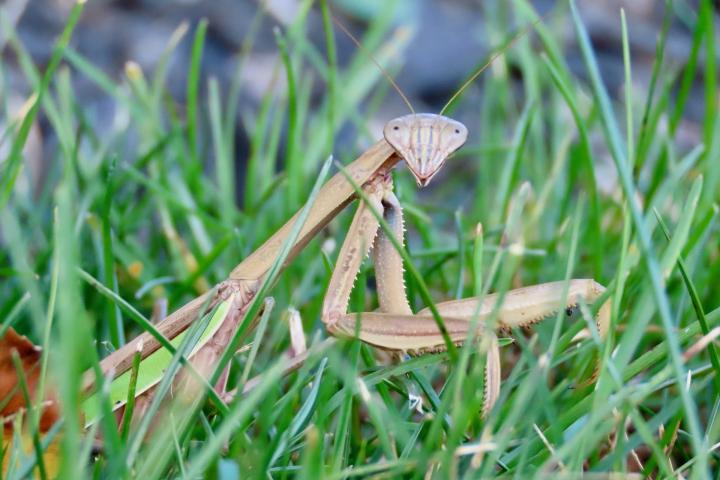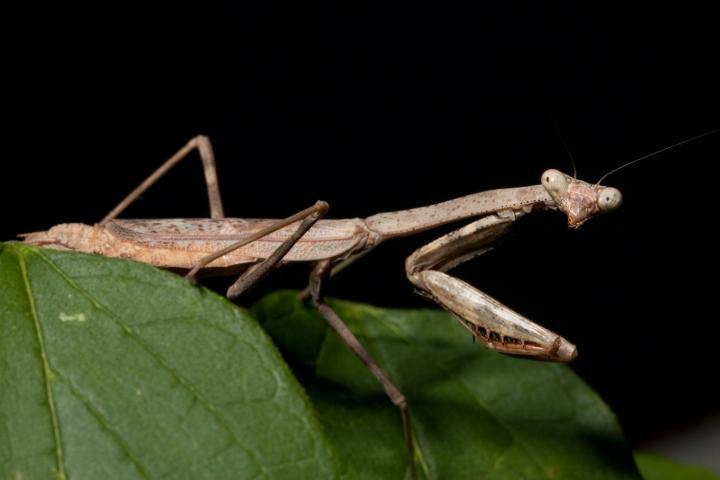
Learn All About This Backyard Beneficial Insect!
The Almanac Garden Planner - Use It Free for 7 Days!
Plan your 2025 garden with our award-winning Garden Planner.
ADVERTISEMENT
I grew up in a suburban area in Ohio, not too far from the country and miles of nothing but farms. I was getting off work one night and as I approached my car in the parking lot, there was maybe a dozen bright green huge Mantids, all over my car, under and around it. Almost as if they were guarding it. I didn't know what to do. I was clearly outnumbered. I left and came back an hour later. By then they were gone. But it was the weirdest thing seeing so many in a parking lot in the 'burbs.
It was early November, 1999 when a mantis was observed at our basement window. We captured her and placed her in a shoebox, and then left for the evening. Upon returning, we opened the box, and to our surprise, she seemingly had escaped. She had actually just hung herself up under the lid.
The next morning, we contacted a professor at our local college, an entomologist. He told us what to feed her, and offered basic care guidance.
She lived with us until early February the next year, and what we learned literally changed our lives.
These are very sentient creatures. Communication is possible using symbols. They easily recognize concepts such as “play”, “eat”, “protect”, “fight”.
Each mantis needs their own room, they are not happy in [mesh] hampers.
A couple of years ago I opened my front door and found a praying mantis on my screen door. I relocated it to a plant on my front porch. Next morning it (or another one that looked like it) was on the screen again. I relocated it a bit farther away on a bush at the front of the yard. Next day, guess what! Another one on the INSIDE of my screen. This one was brown, the other one was green. So I moved it to a tree in the back of the house. No more sightings on the screen door after that. I did find a small one yesterday while pulling weeds.
I was just noticing how much the praying mantis wings look like green leaves; prob. a camouflage~
When I was a kid in Ohio, our science teacher had us collecting egg cases in late spring from a field trip. Our rural community was in the middle of large cornfields and insects were constant inhabitants. We didn’t know what kind they were but she put them in her vented metal cupboard over the summer vacation. When school started again in September, millions of 1 inch baby praying mantis had hatched! The janitors had to sweep them up and throw them outside. They were everywhere!! Even after we were allowed back into the building, I could hear girls scream when they encountered some of the “escapees”. I laughed when I heard these screening ninnies!
Another time, I wasn’t so brave. It was late fall and the corn stalks had dried in our large garden. I heard a really loud commotion in the middle of the cornfield, cornstalks were thrashing all around. I was cautiously curious and quietly walked near enough to see what had caused the commotion. Two huge 4-5” brown mantids were fighting!! They were jumping and flying all around the dry cornstalks. I didn’t stick around to see the outcome but have always wondered about this behavior. Are mantids territorial? Was this a mating ritual? I never found out, and am still just as curious.
What a storyteller you are. Yes, mandids will fight each other, even do the death. It’s quite ruthless. Often they fight to mate—and the losers will get eaten by their own kind!
Just noticed him(?) on plant I was trying to trim. He's brown, about 4 inches biggest I've ever seen. Watched him, looked like he was stalking; then I saw the lanternfly. Mr. mantis went after him, they both fell down the plant so I couldn't see. However the next day I saw just wings of the lanternfly stuck in what looked like some sort of sticky web on my plant. It would be great if more mantises could be a predator to get rid of these lanternflies.!!!
Mantis, of course. The timbre of The Old Farmers Almanac is becoming questionable, at best, and you can print that. Geez!!
I have two in my yard this summer. One is brown and the other is green. Both are about 2 inches long.The green one I picked up in the grass and showed it to the neighbors. It was looking around at the people and back at me. A very unique and calming experience.
I have been watching a mantis all week on my screened porch. She is the biggest one I have ever seen. Over 4 inches and 5 or so with her arms out straight. Beautiful specimen.













